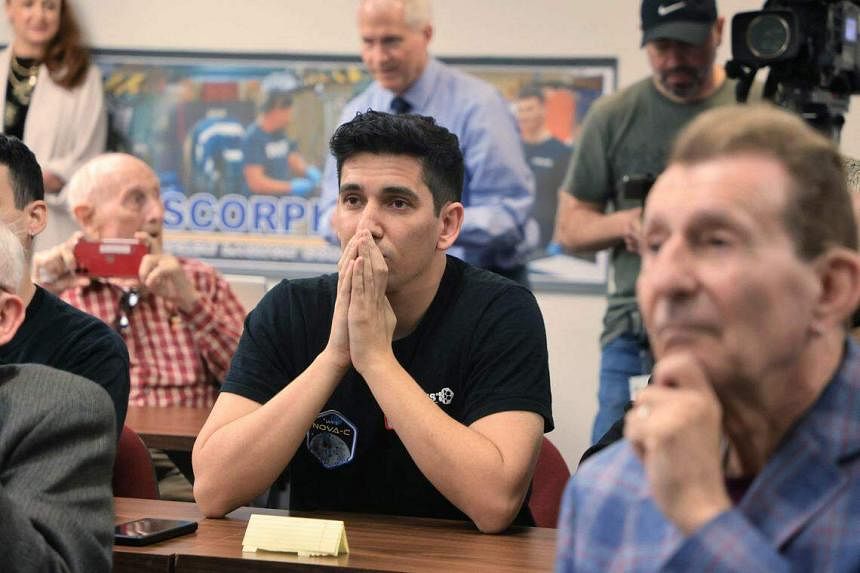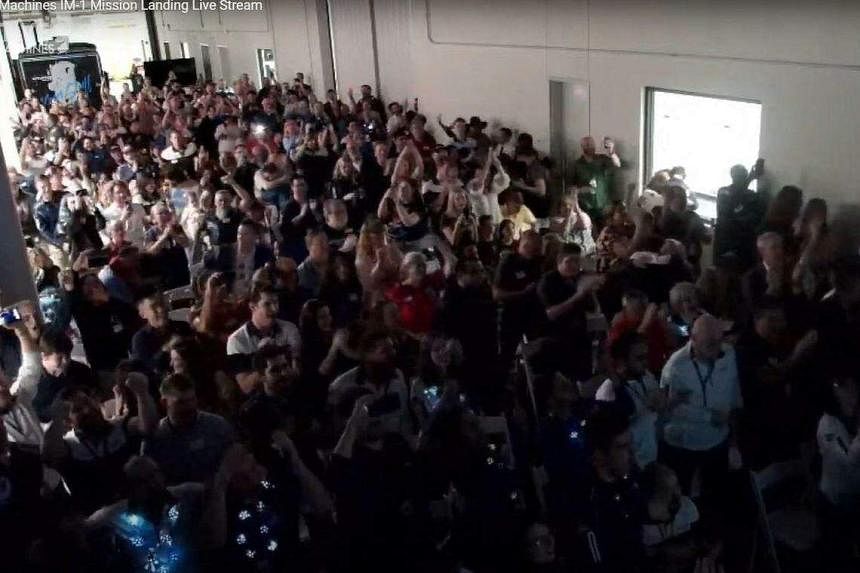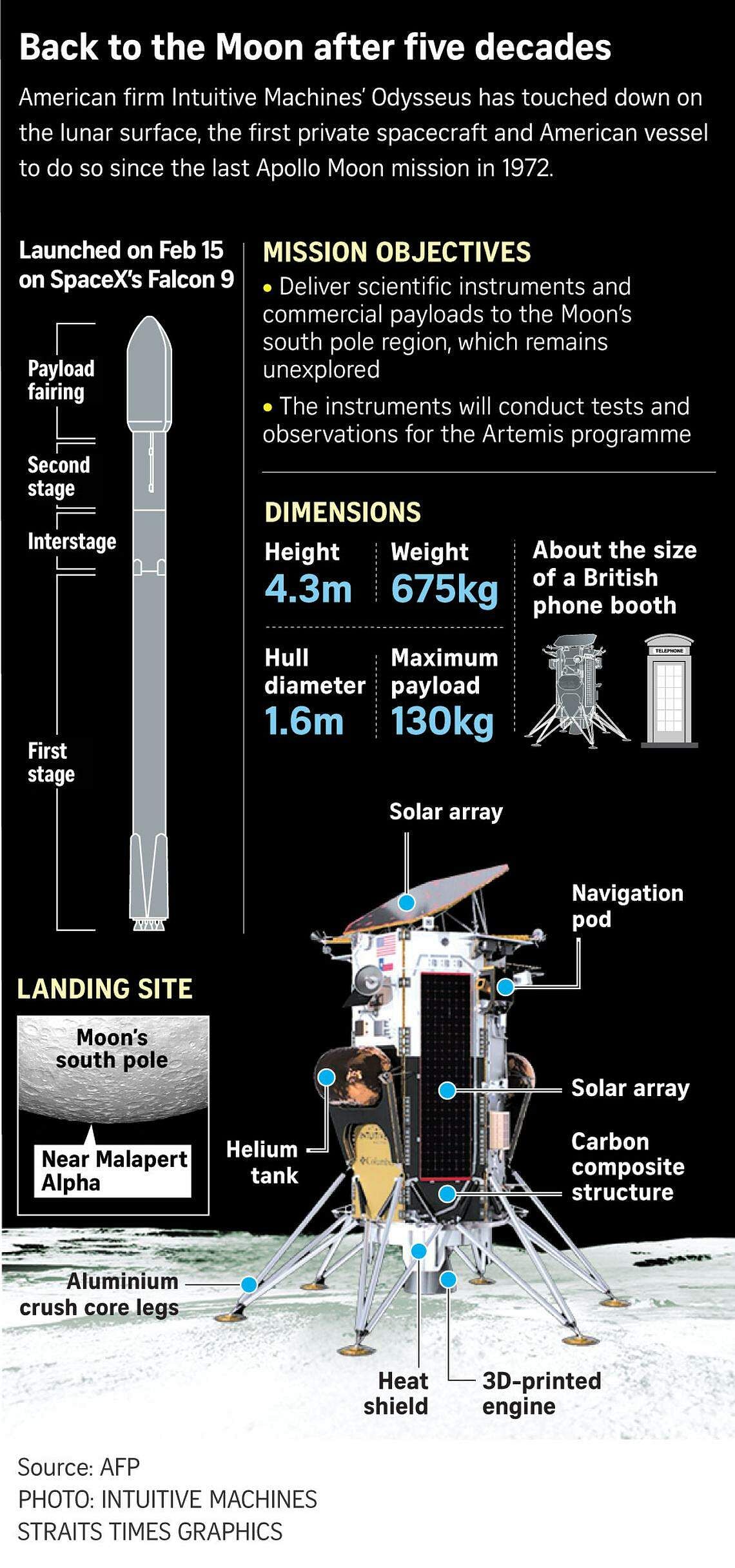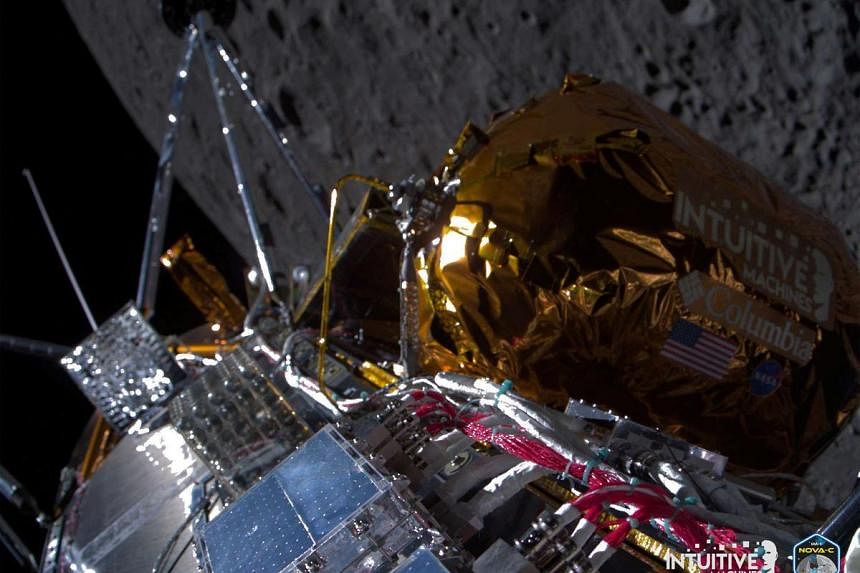TEXAS - The moon lander dubbed Odysseus is “alive and well” but resting on its side a day after its white-knuckle touchdown as the first private spacecraft ever to reach the lunar surface, and the first from the US since 1972, the company behind the vehicle said on Feb 23.
Houston-based space exploration company Intuitive Machines also revealed that human error led to a failure of the spacecraft’s laser-based range finders, how engineers detected the glitch by chance hours before landing time, and how they improvised an emergency fix that saved the mission from a probable crash.
Although the Odysseus made it to the surface intact on Feb 22, analysis of data by flight engineers showed the six-legged craft apparently tripped over its own feet as it neared the end of its final descent, company officials said at a briefing the next day.
The spacecraft is believed to have caught one of its landing feet on the uneven lunar surface and tipped over, coming to rest sideways, propped up on a rock at one end, said chief executive officer Stephen Altemus, whose company built and flew the lander.
Still, all indications are that Odysseus “is stable near or at our intended landing site”, close to a crater called Malapert A in the region of the moon’s south pole, Mr Altemus told reporters.
“We do have communications with the lander,” and mission control operators are sending commands to the vehicle, Mr Altemus said, adding that they were working to obtain the first photo images from the lunar surface from the landing site.
A brief update on the mission’s status posted to the company’s website earlier on Feb 23 described Odysseus as “alive and well”.
The company had said shortly after touchdown on Feb 22 that radio signals indicated Odysseus, a 4m tall hexagonal cylinder, had landed in an upright position, but Mr Atlemus said that faulty conclusion was based on telemetry from before the landing.
Although the lander’s horizontal position is far from ideal, company officials said that all but one of the six Nasa science and technology payloads were mounted on portions of the vehicle left exposed and receptive to communications, “which is very good for us”, said Mr Altemus.
“We think we can meet all the needs of the commercial payloads” as well, he added.
Less promising was the fact that two of the spacecraft's antennae were left pointed at the surface, a circumstance that will limit communications with the lander, Mr Altemus said.
Also the functionality of a solar energy panel on the top of Odysseus, now facing the wrong way, is uncertain, but a second array on the side of the spacecraft appears to be in working order, and the spacecraft's batteries had been fully charged, he said.
The uncrewed robot spacecraft reached the lunar surface on Feb 22 after a nail-biting final approach and descent in which a problem surfaced with the lander's navigation system, requiring engineers on the ground to employ an untested workaround at the 11th hour.
The original laser-powered range finders had been rendered non-functional because company engineers at Nasa’s Kennedy Space Centre in Florida had inadvertently failed to unlock a safety switch before the lander’s launch to space on Feb 15, said Mr Altemus.
“That was an oversight on our part,” he said, likening the overlooked switch to a safety mechanism on a firearm.

The problem was only detected by happenstance a week later during lunar orbit, with just hours to go before landing, when flight controllers were troubleshooting a different issue.
Otherwise, they might only have realised the safety lock was still on when it was time to power up the range finders during the last five minutes of descent, mission director Tim Crain said.
Tensions mounted as engineers determined that existing software aboard the spacecraft could not override the safety lock to activate the range finders, company officials said.
Ultimately, engineers scrambled to write software directing the lander instead to rely on an experimental Nasa Lidar payload onboard – a remote sensing system that uses rapid pulses of laser-like light and their reflections to judge distances between objects.
Intended for use only as a technology demonstration, as well as a possible backup, Nasa’s Lidar saved the day, though it was employed under extreme duress.
“It’s super high-stakes,” former SpaceX mission director Abhi Tripathi said. “The mission director has to make sure everyone does his job, and does his job perfectly, almost like a conductor.”
Mr Crain said the spacecraft, burning a propulsion fuel of liquid methane and liquid oxygen for the first time in space, “performed flawlessly” during its seven-day flight to and in orbit around the moon.

The condition of Odysseus was murky immediately after its landing. It took some time after an anticipated radio blackout to re-establish communications with the spacecraft and determine its fate some 384,000 km from Earth.
When contact was finally renewed, the signal was faint, confirming that the lander had touched down but leaving mission control immediately uncertain as to the precise condition and position of the vehicle, company officials said during a webcast of the event on the evening of Feb 22.
Mr Crain said he believed that the payloads aboard the lander would be able to operate for about nine or 10 days, after which sun will have set on the polar landing site.
Shares of Intuitive Machines tumbled 30 per cent in extended trade on Feb 23, wiping out all their rally in Friday's market session after the company said its moon lander had tipped over. REUTERS


